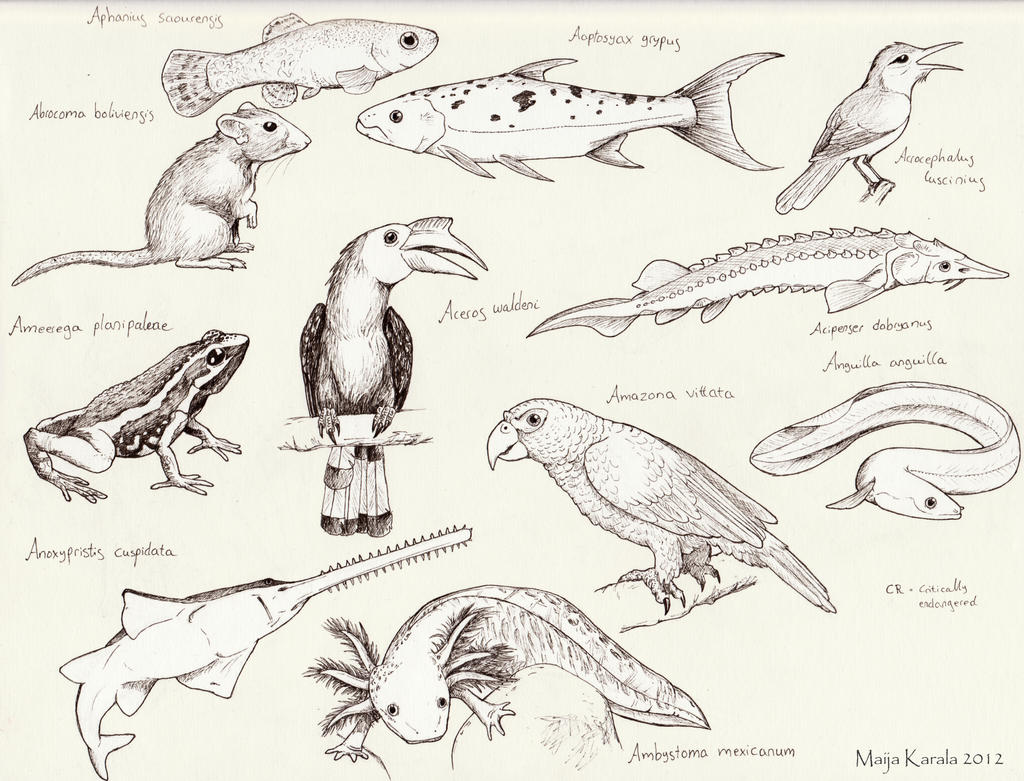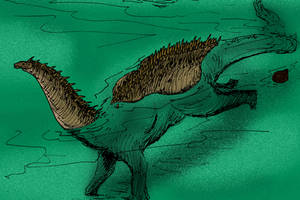ShopDreamUp AI ArtDreamUp
Deviation Actions
Suggested Deviants
Suggested Collections
You Might Like…
Featured in Groups
Badge Awards
Description
Inspired by Earth Day, though I'm a bit late. A series of critically endangered vertebrate species. I started selecting photogenic species from the beginning of IUCN red list, and didn't get past A before running out of space on the paper. There are so many of them...
Most of these animals are likely to go extinct during our lifetime. I wanted to make sure that at least someone has heard about them before they fall into oblivion.
So, what are they?
Aphanius saourensis is a beautifully golden-coloured killifish living in the Saoura river basin in Algeria, in the middle of Sahara desert. It was only described in 2006. It used to be common, but the introduced mosquitofish (Gambusia affinis) from South America has almost completely outcompeted it. The river basin is also getting smaller and smaller, since the locals are using more and more water for agriculture and polluting what's left.
Aaptosyax grypus or the Mekong giant salmon carp is a highly unusual, predatory, salmon-like cyprinid. It can grow to a lenght of more than a meter. The population of the giant salmon carp has dropped by about 90 % during the last ten years, most likely because of overfishing, dams and possibly hydrological changes caused by climate warming. There are more dams being constructed.
Acrocephalus luscinius or the nightingale reed-warbler used to live on Guam, the Pacific island famous for it's astonishing population of introduced brown tree snakes. The warbler is one of the many victims of the snake, but it still survives on the tiny islet of Alamagan (about 350 birds) and the larger island of Saipan (about 2700 birds in 2007). The population on Saipan has been steadily decreasing because of habitat loss, and now there are signs that the brown tree snake has finally reached the island. Given the almost complete destruction of bird communities the snake achieved on Guam, the future of this skilled singer isn't hopeful.
Abrocoma boliviensis is known as the Bolivian chinchilla rat. It only lives on a tiny mountain area in the Andes, in rocky areas of the cloud forests. It's habitats are rapidly being cut down and turned into cattle pastures.
Aceros waldeni, the beautifully coloured Walden's hornbill lives on the islands of Negros and Panay in the Philippines. There are only a few per cent of the original forest cover left on the islands, and it's still being cut down. Hunting and nest poaching are also threats, though conservation measures have reduced them.
Acipenser dabryanus, Dabry's sturgeon, is just an example of the ecological catastrophe that is underway in river Yangtze, China. Critically endangered or extinct species in the area include the biggest freshwater fish in the world, the Chinese paddlefish, an endemic alligator, an unique freshwater dolphin, a subspecies of a finless porpoise and others. Dabry's sturgeon is thought as a national treasure in China and is strictly protected, but it doesn't help if the animal's habitat is being destroyed.
Not much is known about Ameerega planipaleae, or the Oxapampa poison frog. It only lives near Oxapampa town in Peru, high in the Andes. It's very small area of occurrence is destroyed by habitat loss, but a nearby national park might be extended to cover the area.
Anguilla anguilla, the European eel, is the only one of these species that actually occurs in Finland, where I live. The global population is down about 95 to 99 % from 1980, which is a catastrophal loss. These fish migrate to the other side of Atlantic Ocean, to Sargasso Sea to breed, and the weird, leaf-shaped larvae somehow swim back to Europe and colonise the rivers. During 1930s, large, writhing cables of eel larva could still be seen crossing dry land on their way to lakes and ponds. The reason why eels have become so rare is not well known: it might be the dams that stop the larvae from getting up rivers, overfishing, pollution or new diseases.
Amazona vittata is known as the Puerto Rican Amazon. During the 20th century, it's forest habitat was almost completely destroyed and the birds were killed both for food and as pests - and captured for the pet trade. In 1975, there were only thirteen parrots left. A captive breeding program was started at the time, and the population is showing slight signs of recovery: there are about 50 wild birds and 200 captive ones alive now. The situation is still very bad, and hurricanes and thieves have dropped the population from time to time.
Anoxypristis cuspidata, the awesomely named knifetooth sawfish, is a creature of shallow coastal waters. It's widely distributed in the Indian and Western Pacific Oceans, but being common didn't help it much. The long, toothed noses of sawfishes are easily caught in all sorts of nets, which makes it a prime victim of bycatch. It is also deliberately killed for it's meat and liver, and sometimes for Chinese traditional medicine (though what is it supposed to cure, I don't know). The populations seem to have crashed since 1960s, though populations of marine animals are generally poorly known.
Last but not least, Ambystoma mexicanum is a common pet known as the axolotl. This weird salamander never grows up, but stays in it's gilled, aquatic larval form all it's life. It only lives in two lakes in Mexico: Lake Chalco and Lake Xochimilco. The problem is, Chalco doesn't exist anymore, since it has been artificially drained, and Xochimilco is not much better: both "lakes" now mainly consist of seriously polluted canals, and the population is a few hundred individuals at most. They are still hunted for food. Because of the widespread captive breeding, the axolotl is not going extinct anytime soon, but it might move to the "extinct in the wild" category.
Most of these animals are likely to go extinct during our lifetime. I wanted to make sure that at least someone has heard about them before they fall into oblivion.
So, what are they?
Aphanius saourensis is a beautifully golden-coloured killifish living in the Saoura river basin in Algeria, in the middle of Sahara desert. It was only described in 2006. It used to be common, but the introduced mosquitofish (Gambusia affinis) from South America has almost completely outcompeted it. The river basin is also getting smaller and smaller, since the locals are using more and more water for agriculture and polluting what's left.
Aaptosyax grypus or the Mekong giant salmon carp is a highly unusual, predatory, salmon-like cyprinid. It can grow to a lenght of more than a meter. The population of the giant salmon carp has dropped by about 90 % during the last ten years, most likely because of overfishing, dams and possibly hydrological changes caused by climate warming. There are more dams being constructed.
Acrocephalus luscinius or the nightingale reed-warbler used to live on Guam, the Pacific island famous for it's astonishing population of introduced brown tree snakes. The warbler is one of the many victims of the snake, but it still survives on the tiny islet of Alamagan (about 350 birds) and the larger island of Saipan (about 2700 birds in 2007). The population on Saipan has been steadily decreasing because of habitat loss, and now there are signs that the brown tree snake has finally reached the island. Given the almost complete destruction of bird communities the snake achieved on Guam, the future of this skilled singer isn't hopeful.
Abrocoma boliviensis is known as the Bolivian chinchilla rat. It only lives on a tiny mountain area in the Andes, in rocky areas of the cloud forests. It's habitats are rapidly being cut down and turned into cattle pastures.
Aceros waldeni, the beautifully coloured Walden's hornbill lives on the islands of Negros and Panay in the Philippines. There are only a few per cent of the original forest cover left on the islands, and it's still being cut down. Hunting and nest poaching are also threats, though conservation measures have reduced them.
Acipenser dabryanus, Dabry's sturgeon, is just an example of the ecological catastrophe that is underway in river Yangtze, China. Critically endangered or extinct species in the area include the biggest freshwater fish in the world, the Chinese paddlefish, an endemic alligator, an unique freshwater dolphin, a subspecies of a finless porpoise and others. Dabry's sturgeon is thought as a national treasure in China and is strictly protected, but it doesn't help if the animal's habitat is being destroyed.
Not much is known about Ameerega planipaleae, or the Oxapampa poison frog. It only lives near Oxapampa town in Peru, high in the Andes. It's very small area of occurrence is destroyed by habitat loss, but a nearby national park might be extended to cover the area.
Anguilla anguilla, the European eel, is the only one of these species that actually occurs in Finland, where I live. The global population is down about 95 to 99 % from 1980, which is a catastrophal loss. These fish migrate to the other side of Atlantic Ocean, to Sargasso Sea to breed, and the weird, leaf-shaped larvae somehow swim back to Europe and colonise the rivers. During 1930s, large, writhing cables of eel larva could still be seen crossing dry land on their way to lakes and ponds. The reason why eels have become so rare is not well known: it might be the dams that stop the larvae from getting up rivers, overfishing, pollution or new diseases.
Amazona vittata is known as the Puerto Rican Amazon. During the 20th century, it's forest habitat was almost completely destroyed and the birds were killed both for food and as pests - and captured for the pet trade. In 1975, there were only thirteen parrots left. A captive breeding program was started at the time, and the population is showing slight signs of recovery: there are about 50 wild birds and 200 captive ones alive now. The situation is still very bad, and hurricanes and thieves have dropped the population from time to time.
Anoxypristis cuspidata, the awesomely named knifetooth sawfish, is a creature of shallow coastal waters. It's widely distributed in the Indian and Western Pacific Oceans, but being common didn't help it much. The long, toothed noses of sawfishes are easily caught in all sorts of nets, which makes it a prime victim of bycatch. It is also deliberately killed for it's meat and liver, and sometimes for Chinese traditional medicine (though what is it supposed to cure, I don't know). The populations seem to have crashed since 1960s, though populations of marine animals are generally poorly known.
Last but not least, Ambystoma mexicanum is a common pet known as the axolotl. This weird salamander never grows up, but stays in it's gilled, aquatic larval form all it's life. It only lives in two lakes in Mexico: Lake Chalco and Lake Xochimilco. The problem is, Chalco doesn't exist anymore, since it has been artificially drained, and Xochimilco is not much better: both "lakes" now mainly consist of seriously polluted canals, and the population is a few hundred individuals at most. They are still hunted for food. Because of the widespread captive breeding, the axolotl is not going extinct anytime soon, but it might move to the "extinct in the wild" category.
Image size
6523x4972px 28.55 MB
Comments69
Join the community to add your comment. Already a deviant? Log In
Nice art
































